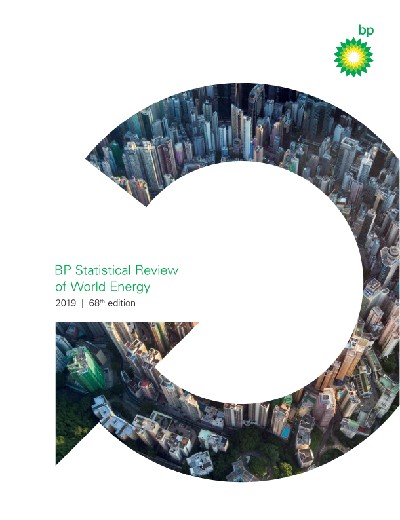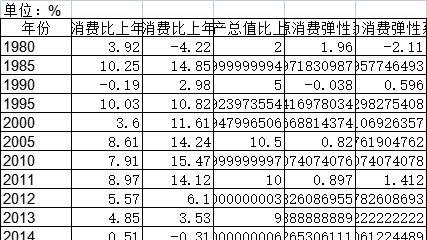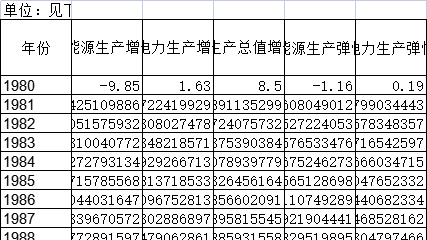"中国基尼系数住户统计年鉴"相关数据
更新时间:2024-10-292019世界能源统计年鉴
In particular,the data compiled in this year's Review suggest that in 2018,global energy demand and carbon emissions from energy use grew at their fastest rate since 2010/11,moving even fur ther away from the accelerated transition envisaged by the Paris climate goals.
BP's economics team estimate that much of the rise in energy growth last year can be traced back to weather-related effects,as farmilies and businesses increased their demand for cooling and heating in response to an unusually large number of hot and cold days.The acceleration in carbon emissions was the direct result of this increased energy consumption.
Even if these weather effects are short-lived,such that the growth in energy demand and carbon emissions slow over the next few years,there seems lttle doubt that the current pace of progress is inconsistent with the Paris climate goals.The world is on an unsustainable path:the longer carbon emissions continue to rise,the harder and more costly will be the eventual adjustment to net-zero carbon emissions.Yet another year of growing carbon emissions underscores the urgency for the world to change.
The Statistical Review provides a timely and objective insight into those developments and how that change can begin to be achieved.
The strength iท energy consumption was reflected acroรs all the fuels,many of which grew more strongly than their recent historical averages.This acceleration was particularly pronounced for natural gas,which grew at one of its fastest rates for over 30 years,accounting for over 40% of the growth in primary energy.On the supply side,the data for 2018 reinforced the central importance of the US shale revolution.
【更多详情,请下载:2019世界能源统计年鉴】

 2010-2019年全球受访国家财富指数基尼系数的调查统计数据本数据记录了2010-2019年全球受访国家财富指数基尼系数的调查统计数据。调查内容为基尼系数表示该国财富的集中程度。2010-2019年发布时间:2021-01-20
2010-2019年全球受访国家财富指数基尼系数的调查统计数据本数据记录了2010-2019年全球受访国家财富指数基尼系数的调查统计数据。调查内容为基尼系数表示该国财富的集中程度。2010-2019年发布时间:2021-01-20 2000-2017年北京市能源消费弹性系数该数据包含了2000-2017年北京市能源消费弹性系数。2003能源消费比上年增长为4.78%。2000-2017年发布时间:2021-07-08
2000-2017年北京市能源消费弹性系数该数据包含了2000-2017年北京市能源消费弹性系数。2003能源消费比上年增长为4.78%。2000-2017年发布时间:2021-07-08 1967-2018年全球166个国家和地区基尼(GINI)系数该数据包含了1967-2018年全球166个国家和地区基尼(GINI)系数。阿尔巴尼亚2017年为33.2,2016年为33.7,2015年为32.9,2014年为34.6,2012年为29。1967-2018年发布时间:2020-12-10
1967-2018年全球166个国家和地区基尼(GINI)系数该数据包含了1967-2018年全球166个国家和地区基尼(GINI)系数。阿尔巴尼亚2017年为33.2,2016年为33.7,2015年为32.9,2014年为34.6,2012年为29。1967-2018年发布时间:2020-12-10 截至2020年山西省主要年份能源消费弹性系数该数据包含了截至2020年山西省主要年份能源消费弹性系数。1980年能源消费比上年增长为3.92%。2020年发布时间:2022-08-08
截至2020年山西省主要年份能源消费弹性系数该数据包含了截至2020年山西省主要年份能源消费弹性系数。1980年能源消费比上年增长为3.92%。2020年发布时间:2022-08-08 截至2020年山西省主要年份能源生产弹性系数该数据包含了截至2020年山西省主要年份能源生产弹性系数。1980年能源生产比上年增长为11.1%。2020年发布时间:2022-08-08
截至2020年山西省主要年份能源生产弹性系数该数据包含了截至2020年山西省主要年份能源生产弹性系数。1980年能源生产比上年增长为11.1%。2020年发布时间:2022-08-08 截至2014年北京市能源消费弹性系数该数据包含了截至2014年北京市能源消费弹性系数。2000能源消费比上年增长为6.08%,电力消费比上年增长为9.53%,地区生产总值比上年增长为11.8%,能源消费弹性系数为0.51,电力消费弹性系数为0.81。2014年发布时间:2021-07-21
截至2014年北京市能源消费弹性系数该数据包含了截至2014年北京市能源消费弹性系数。2000能源消费比上年增长为6.08%,电力消费比上年增长为9.53%,地区生产总值比上年增长为11.8%,能源消费弹性系数为0.51,电力消费弹性系数为0.81。2014年发布时间:2021-07-21 截至2020年福建省能源消费弹性系数该数据包含了截至2020年福建省能源消费弹性系数。1990年能源消费比上年增长为3.87%。2020年发布时间:2022-08-24
截至2020年福建省能源消费弹性系数该数据包含了截至2020年福建省能源消费弹性系数。1990年能源消费比上年增长为3.87%。2020年发布时间:2022-08-24 截至2020年广东省能源消费弹性系数该数据包含了截至2020年广东省能源消费弹性系数。1986年能源消费比上年增长为8.4%。2020年发布时间:2022-05-17
截至2020年广东省能源消费弹性系数该数据包含了截至2020年广东省能源消费弹性系数。1986年能源消费比上年增长为8.4%。2020年发布时间:2022-05-17 1979-2017年全球161个国家世界银行估计的基尼系数基尼系数衡量的是经济体内个人或家庭之间的收入分配(或在某些情况下为消费支出)偏离完全均等分配的程度。基尼系数为0表示完全平等,而指数100则表示完全不平等。1979-2017年发布时间:2020-07-02
1979-2017年全球161个国家世界银行估计的基尼系数基尼系数衡量的是经济体内个人或家庭之间的收入分配(或在某些情况下为消费支出)偏离完全均等分配的程度。基尼系数为0表示完全平等,而指数100则表示完全不平等。1979-2017年发布时间:2020-07-02 2002-2009年北京市能源消费弹性系数该数据包含了2002-2009年北京市能源消费弹性系数。能源消费比上年增长2002为4.89。2002-2009年发布时间:2021-09-14
2002-2009年北京市能源消费弹性系数该数据包含了2002-2009年北京市能源消费弹性系数。能源消费比上年增长2002为4.89。2002-2009年发布时间:2021-09-14 2000-2016年北京市能源消费弹性系数该数据包含了2000-2016年北京市能源消费弹性系数。2000能源消费比上年增长为6.08%。2000-2016年发布时间:2021-07-21
2000-2016年北京市能源消费弹性系数该数据包含了2000-2016年北京市能源消费弹性系数。2000能源消费比上年增长为6.08%。2000-2016年发布时间:2021-07-21 截至2020年内蒙古能源消费弹性系数该数据包含了截至2020年内蒙古能源消费弹性系数。1986年能源消费比上年增长为1.97%。2020年发布时间:2022-08-15
截至2020年内蒙古能源消费弹性系数该数据包含了截至2020年内蒙古能源消费弹性系数。1986年能源消费比上年增长为1.97%。2020年发布时间:2022-08-15 截至2020年内蒙古能源生产弹性系数该数据包含了截至2020年内蒙古能源生产弹性系数。1984年能源生产比上年增长为10.15%。2020年发布时间:2022-08-15
截至2020年内蒙古能源生产弹性系数该数据包含了截至2020年内蒙古能源生产弹性系数。1984年能源生产比上年增长为10.15%。2020年发布时间:2022-08-15 1991-2018年天津能源消费弹性系数该数据包含了1991-2018年天津能源消费弹性系数。1991能源消费比上年增长-2.4%。1991-2018年发布时间:2021-03-10
1991-2018年天津能源消费弹性系数该数据包含了1991-2018年天津能源消费弹性系数。1991能源消费比上年增长-2.4%。1991-2018年发布时间:2021-03-10 2000-2020年中国能源弹性系数(年度)该数据包含了2000-2020年中国能源弹性系数(年度)。2004年能源生产弹性系数为1.54,电力生产弹性系数为1.51,能源消费弹性系数为1.66,电力消费弹性系数为1.52。2000-2020年发布时间:2022-05-06
2000-2020年中国能源弹性系数(年度)该数据包含了2000-2020年中国能源弹性系数(年度)。2004年能源生产弹性系数为1.54,电力生产弹性系数为1.51,能源消费弹性系数为1.66,电力消费弹性系数为1.52。2000-2020年发布时间:2022-05-06 1978-2021年中国居民恩格尔系数(年度)该数据包含了1978-2021年中国居民恩格尔系数(年度)。1978年居民恩格尔系数为63.9%,城镇居民恩格尔系数为57.5%,农村居民恩格尔系数为67.7%。1978-2021年发布时间:2022-05-06
1978-2021年中国居民恩格尔系数(年度)该数据包含了1978-2021年中国居民恩格尔系数(年度)。1978年居民恩格尔系数为63.9%,城镇居民恩格尔系数为57.5%,农村居民恩格尔系数为67.7%。1978-2021年发布时间:2022-05-06 1980-2020年云南省全省能源生产弹性系数该数据包含了1980年-2020年云南省全省能源生产弹性系数。1980年当年能源生产增长为-9.85%。1980-2020年发布时间:2022-03-30
1980-2020年云南省全省能源生产弹性系数该数据包含了1980年-2020年云南省全省能源生产弹性系数。1980年当年能源生产增长为-9.85%。1980-2020年发布时间:2022-03-30 1980-2020年云南省全省能源消费弹性系数该数据包含了1980年-2020年云南省全省能源消费弹性系数。1980年当年能源消费增长为-11.76%。1980-2020年发布时间:2022-03-30
1980-2020年云南省全省能源消费弹性系数该数据包含了1980年-2020年云南省全省能源消费弹性系数。1980年当年能源消费增长为-11.76%。1980-2020年发布时间:2022-03-30 1990-2018年浙江省能源消费弹性系数该数据包含了1990年-2018年浙江省能源消费弹性系数。1990年全省能源消费量2732.86万吨标准煤。1990-2018年发布时间:2021-02-23
1990-2018年浙江省能源消费弹性系数该数据包含了1990年-2018年浙江省能源消费弹性系数。1990年全省能源消费量2732.86万吨标准煤。1990-2018年发布时间:2021-02-23 1990-2018年浙江省能源生产弹性系数该数据包含了1990年-2018年浙江省能源生产弹性系数。1990年全省能源生产量317.18万吨标准煤。1990-2018年发布时间:2021-02-23
1990-2018年浙江省能源生产弹性系数该数据包含了1990年-2018年浙江省能源生产弹性系数。1990年全省能源生产量317.18万吨标准煤。1990-2018年发布时间:2021-02-23





